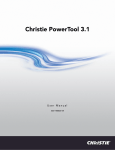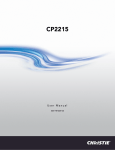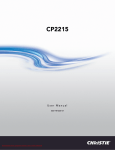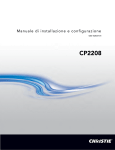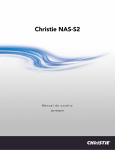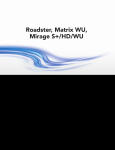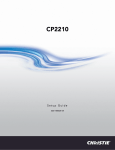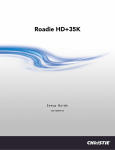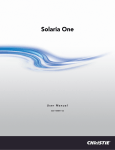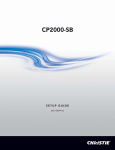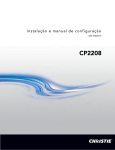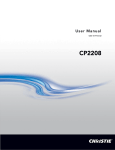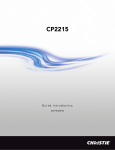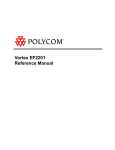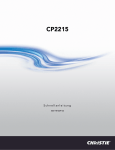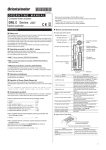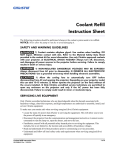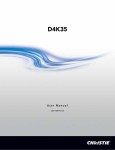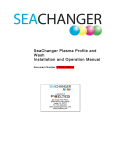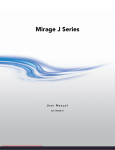Download CP2215 Quick Start Guide
Transcript
CP2215 Quick Start Guide 020-101295-02 NOTICES COPYRIGHT AND TRADEMARKS © 2015 Christie Digital Systems USA Inc. All rights reserved. All brand names and product names are trademarks, registered trademarks or trade names of their respective holders. REGULATORY The product has been tested and found to comply with the limits for a Class A digital device, pursuant to Part 15 of the FCC Rules. These limits are designed to provide reasonable protection against harmful interference when the product is operated in a commercial environment. The product generates, uses, and can radiate radio frequency energy and, if not installed and used in accordance with the instruction manual, may cause harmful interference to radio communications. Operation of the product in a residential area is likely to cause harmful interference in which case the user will be required to correct the interference at the user’s own expense. CAN ICES-3 (A) / NMB-3 (A) 㧊 ₆₆⓪ 㠛ⶊ㣿 (A ) 㦒⪲ 㩚㧦䕢㩗䞿❇⪳㦚 䞲 ₆₆㧊㡺┞ 䕦ⰺ㧦 ⡦⓪ ㌂㣿㧦⓪ 㧊㩦㦚 㭒㦮䞮㔲₆ ⧒Ⳇ , Ṗ㩫 㣎㦮 㰖㡃㠦 ㍲ ㌂㣿䞮⓪ ộ㦚 ⳿㩗㦒⪲ 䞿┞┺ . GENERAL Every effort has been made to ensure accuracy, however in some cases changes in the products or availability could occur which may not be reflected in this document. Christie reserves the right to make changes to specifications at any time without notice. Performance specifications are typical, but may vary depending on conditions beyond Christie's control such as maintenance of the product in proper working conditions. Performance specifications are based on information available at the time of printing. Christie makes no warranty of any kind with regard to this material, including, but not limited to, implied warranties of fitness for a particular purpose. Christie will not be liable for errors contained herein or for incidental or consequential damages in connection with the performance or use of this material. The product is designed and manufactured with high-quality materials and components that can be recycled and reused. This symbol means that electrical and electronic equipment, at their end-of-life, should be disposed of separately from regular waste. Please dispose of the product appropriately and according to local regulations. In the European Union, there are separate collection systems for used electrical and electronic products. Please help us to conserve the environment we live in. Canadian manufacturing facility is ISO 9001 and 14001 certified. GENERAL WARRANTY STATEMENTS For complete information about Christie’s limited warranty, see the Christie website (www.christiedigital.com) or contact your Christie dealer. In addition to the limitations that may be specified in Christie’s limited warranty, the warranty does not cover: a. Problems or damage occurring during shipment, in either direction. b. Projector lamps (See Christie’s separate lamp program policy). c. Problems or damage caused by use of a projector lamp beyond the recommended lamp life, or use of a lamp supplied by a supplier other than Christie or an authorized distributor of Christie lamps. d. Problems or damage caused by combination of a Product with non-Christie equipment, such as distribution systems, cameras, DVD players, etc., or use of a Product with any non-Christie interface device. e. Problems or damage caused by the use of any lamp, replacement part or component purchased or obtained from an unauthorized distributor of Christie lamps, replacement parts or components including, without limitation, any distributor offering Christie lamps, replacement parts or components through the internet (confirmation of authorized distributors may be obtained from Christie). f. Problems or damage caused by misuse, improper power source, accident, fire, flood, lightening, earthquake or other natural disaster. g. Problems or damage caused by improper installation/alignment, or by equipment modification, if by other than Christie service personnel or a Christie authorized repair service provider. h. Problems or damage caused by use of a Product on a motion platform or other movable device where such Product has not been designed, modified or approved by Christie for such use. i. Problems or damage caused by use of a projector in the presence of an oil-based fog machine or laser-based lighting that is unrelated to the projector. j. For LCD projectors, the warranty period applies only where the LCD projector is in “normal use.” “Normal use” means the LCD projector is not used more than 8 hours a day, 5 days a week. k. Except where the Product is designed for outdoor use, problems or damage caused by use of the Product outdoors unless (i) such Product is protected from precipitation or other adverse weather or environmental conditions and the ambient temperature is within the recommended ambient temperature set forth in the specifications for such Product and (ii) if the Product is an LCD flat panel, such LCD flat panel is not exposed to direct sunlight. l. Image retention on LCD flat panels. m.Defects caused by normal wear and tear or otherwise due to normal aging of a Product. n. Products where the serial number has been removed or obliterated. o. Products sold by a Reseller to an End User outside of the country where the Reseller is located unless (i) Christie has an office in the country where the End User is located or (ii) the required international warranty fee has been paid. p. Products when there is failure to perform maintenance as required and in accordance with the maintenance schedule. q. This warranty does not obligate Christie to provide any on site warranty service at the Product site location. PREVENTATIVE MAINTENANCE Preventative maintenance is an important part of the continued and proper operation of your product. Please see the Maintenance section for specific maintenance items as they relate to your product. Failure to perform maintenance as required, and in accordance with the maintenance schedule specified by Christie, will void the warranty. Table of Contents Installation and Setup . . . . . . . . . . . . . . . . . . . . . . . . . . . . . . . . . . . . . . . . . . . . 1 Safety Precautions . . . . . . . . . . . . . . . . . . . . . . . . . . . . . . . . . . . . . . . . . . . . . . 1 AC/Power Precautions . . . . . . . . . . . . . . . . . . . . . . . . . . . . . . . . . . . . . . . . . . 2 Power Cords and Attachments . . . . . . . . . . . . . . . . . . . . . . . . . . . . . . . . . . . . 2 Lamp Precautions . . . . . . . . . . . . . . . . . . . . . . . . . . . . . . . . . . . . . . . . . . . . . 3 Projector Components - Front ...................................... 3 Projector Components - Rear . . . . . . . . . . . . . . . . . . . . . . . . . . . . . . . . . . . . . . . 4 Position the Projector . . . . . . . . . . . . . . . . . . . . . . . . . . . . . . . . . . . . . . . . . . . . 4 Adjust Tilt and Level the Projector ................................... 5 Install the Touch Panel Controller . . . . . . . . . . . . . . . . . . . . . . . . . . . . . . . . . . . . 5 Connect the Exhaust Duct . . . . . . . . . . . . . . . . . . . . . . . . . . . . . . . . . . . . . . . . . 6 Install the Lens ................................................ 7 Install the Lamp . . . . . . . . . . . . . . . . . . . . . . . . . . . . . . . . . . . . . . . . . . . . . . . . 8 Connect Devices to the Projector . . . . . . . . . . . . . . . . . . . . . . . . . . . . . . . . . . . . 10 Projector Connections and Status LEDs . . . . . . . . . . . . . . . . . . . . . . . . . . . . . . 10 Connect the Projector to a Computer . . . . . . . . . . . . . . . . . . . . . . . . . . . . . . . 12 Connect Devices to the 3D Terminal . . . . . . . . . . . . . . . . . . . . . . . . . . . . . . . . 12 Connect Devices to the GPIO Port . . . . . . . . . . . . . . . . . . . . . . . . . . . . . . . . . . 12 Connect Power . . . . . . . . . . . . . . . . . . . . . . . . . . . . . . . . . . . . . . . . . . . . . . . . . 14 Turn the Projector On . . . . . . . . . . . . . . . . . . . . . . . . . . . . . . . . . . . . . . . . . . . . 15 Log On to the Projector . . . . . . . . . . . . . . . . . . . . . . . . . . . . . . . . . . . . . . . . . . . 16 Activate Marriage . . . . . . . . . . . . . . . . . . . . . . . . . . . . . . . . . . . . . . . . . . . . . . . 16 Add the Projector to a Network . . . . . . . . . . . . . . . . . . . . . . . . . . . . . . . . . . . . . . 16 Add the Lamp Information to the Lamp History . . . . . . . . . . . . . . . . . . . . . . . . . . . 17 Turn the Lamp On . . . . . . . . . . . . . . . . . . . . . . . . . . . . . . . . . . . . . . . . . . . . . . 18 Align the Lamp with LampLOC . . . . . . . . . . . . . . . . . . . . . . . . . . . . . . . . . . . . . . 18 Adjust the Image to Fit Your Screen . . . . . . . . . . . . . . . . . . . . . . . . . . . . . . . . . . 18 Play Content . . . . . . . . . . . . . . . . . . . . . . . . . . . . . . . . . . . . . . . . . . . . . . . . . . 19 Unencrypted Content . . . . . . . . . . . . . . . . . . . . . . . . . . . . . . . . . . . . . . . . . . 19 Encrypted Content . . . . . . . . . . . . . . . . . . . . . . . . . . . . . . . . . . . . . . . . . . . . 20 Maintenance . . . . . . . . . . . . . . . . . . . . . . . . . . . . . . . . . . . . . . . . . . . . . . . . . . . 21 Inspect Ventilation . . . . . . . . . . . . . . . . . . . . . . . . . . . . . . . . . . . . . . . . . . . . . . 21 Check the Coolant Level . . . . . . . . . . . . . . . . . . . . . . . . . . . . . . . . . . . . . . . . . . 21 Clean the Radiator Filter . . . . . . . . . . . . . . . . . . . . . . . . . . . . . . . . . . . . . . . . . . 22 Inspect the Lamp . . . . . . . . . . . . . . . . . . . . . . . . . . . . . . . . . . . . . . . . . . . . . . . 23 CP2215 Quick Start Guide 020-101295-02 Rev. 1 (04-2015) i Inspect and Clean Optics . . . . . . . . . . . . . . . . . . . . . . . . . . . . . . . . . . . . . . . . . . 23 Clean the Lens . . . . . . . . . . . . . . . . . . . . . . . . . . . . . . . . . . . . . . . . . . . . . . . 24 Replace the Lamp . . . . . . . . . . . . . . . . . . . . . . . . . . . . . . . . . . . . . . . . . . . . . . . 24 Remove the Existing Lamp . . . . . . . . . . . . . . . . . . . . . . . . . . . . . . . . . . . . . . 25 Install the New Lamp . . . . . . . . . . . . . . . . . . . . . . . . . . . . . . . . . . . . . . . . . . 26 Inspect the Card Cage Filter . . . . . . . . . . . . . . . . . . . . . . . . . . . . . . . . . . . . . . . . 28 Cleaning a Washable Filter . . . . . . . . . . . . . . . . . . . . . . . . . . . . . . . . . . . . . . . . . 28 Replace the Lens . . . . . . . . . . . . . . . . . . . . . . . . . . . . . . . . . . . . . . . . . . . . . . . 29 Specifications . . . . . . . . . . . . . . . . . . . . . . . . . . . . . . . . . . . . . . . . . . . . . . . . . . 30 Power Requirements . . . . . . . . . . . . . . . . . . . . . . . . . . . . . . . . . . . . . . . . . . . . . 30 AC Input (A) . . . . . . . . . . . . . . . . . . . . . . . . . . . . . . . . . . . . . . . . . . . . . . . . 30 UPS AC Input (B) . . . . . . . . . . . . . . . . . . . . . . . . . . . . . . . . . . . . . . . . . . . . . 30 Lamp . . . . . . . . . . . . . . . . . . . . . . . . . . . . . . . . . . . . . . . . . . . . . . . . . . . . . 31 Physical Specifications . . . . . . . . . . . . . . . . . . . . . . . . . . . . . . . . . . . . . . . . . . . . 31 Regulatory . . . . . . . . . . . . . . . . . . . . . . . . . . . . . . . . . . . . . . . . . . . . . . . . . . . . 32 Safety . . . . . . . . . . . . . . . . . . . . . . . . . . . . . . . . . . . . . . . . . . . . . . . . . . . . 32 Electro-Magnetic Compatibility . . . . . . . . . . . . . . . . . . . . . . . . . . . . . . . . . . . . 32 Environmental . . . . . . . . . . . . . . . . . . . . . . . . . . . . . . . . . . . . . . . . . . . . . . . 32 Certification Approvals . . . . . . . . . . . . . . . . . . . . . . . . . . . . . . . . . . . . . . . . . 32 Environment . . . . . . . . . . . . . . . . . . . . . . . . . . . . . . . . . . . . . . . . . . . . . . . . . . 33 Operating Environment . . . . . . . . . . . . . . . . . . . . . . . . . . . . . . . . . . . . . . . . . 33 Non-Operating Environment . . . . . . . . . . . . . . . . . . . . . . . . . . . . . . . . . . . . . . 33 Accessories . . . . . . . . . . . . . . . . . . . . . . . . . . . . . . . . . . . . . . . . . . . . . . . . . . . 34 Standard (sold with product) . . . . . . . . . . . . . . . . . . . . . . . . . . . . . . . . . . . . 34 Optional Accessories . . . . . . . . . . . . . . . . . . . . . . . . . . . . . . . . . . . . . . . . . . 34 CP2215 Quick Start Guide 020-101295-02 Rev. 1 (04-2015) ii Installation and Setup This manual is intended for professionally trained operators of Christie high-brightness projection systems. These operators are qualified to replace the lamp and air filter, but should not attempt to install or service the projector. Only accredited Christie technicians who are knowledgeable about the hazards associated with high-voltage, ultraviolet exposure, and the high temperatures generated by the projector lamp are authorized to assemble, install, and service the projector. In addition, only Christie accredited personnel are authorized to perform security procedures such as marriage. This section provides information and procedures for positioning and installing the projector. Safety Precautions When installing the projector, observe these important safety rules to avoid personal injury or damage to the projector: When accessing a restricted access location for projector service or maintenance, avoid exposure to the projector beam path by making sure to either: • Turn the projector power off and disconnect the projector from AC power • Shutter the lamp to avoid emissions from the front aperture Failure to comply results in death or serious injury. • Never look directly into the projector lens or at the lamp. The extremely high brightness can cause permanent eye damage. For protection from ultraviolet radiation, keep all projector housings intact during operation. Protective safety clothing and safety goggles are recommended during servicing. Failure to comply could result in death or serious injury. • FIRE HAZARD! Keep hands, clothes, and all combustible material away from the concentrated light beam of the lamp. Failure to comply could result in death or serious injury. Position all cables where they cannot contact hot surfaces or be pulled or tripped over. Failure to comply could result in minor or moderate injury. This projector must be operated in an environment that meets the operating range specification. See Operating Environment in the CP2215 User Manual. CP2215 Quick Start Guide 020-101295-02 Rev. 1 (04-2015) 1 Installation and Setup AC/Power Precautions • Use only the AC power cord that is provided with the projector. DO NOT attempt operation if the AC supply is not within the specified voltage and power range. Failure to comply could result in death or serious injury. • As a safety feature the projector is equipped with a three-wire plug with a third (grounding) pin. If you are unable to insert the plug into the outlet, contact an electrician to have the outlet replaced. DO NOT defeat the safety purpose of the grounding-type plug. Failure to comply could result in death or serious injury. • DO NOT attempt operation if the AC supply is not within the rated voltage range, as specified on the license label. Failure to comply could result in death or serious injury. • Disconnect projector from AC before opening any enclosure. Failure to comply could result in death or serious injury. • The dedicated earth wire can only be installed by a Christie accredited service technician or an electrician. The protected earth wire must be green/yellow 12 AWG minimum. • DO NOT allow anything to rest on the power cord. Locate the projector where the cord cannot be damaged by persons walking on it or objects rolling over it. Never operate the projector if the power cable appears damaged in any way. Failure to comply could result in minor or moderate injury. • DO NOT overload power outlets and extension cords as this can result in fire or shock hazards. Failure to comply could result in minor or moderate injury. • Only qualified service technicians are permitted to open projector enclosures and only if the projector is disconnected from AC power. Failure to comply could result in minor or moderate injury. Power Cords and Attachments A power cord rated for your region is provided with each projector. Make sure that you are using a power cord, socket, and power plug that meets the appropriate local rating standards. Use only an AC power cord recommended by Christie. DO NOT attempt operation if the AC supply and cord are not within the specified voltage and power range. Failure to comply could result in death or serious injury. Use only the attachments and/or accessories recommended by Christie. Use of others may result in the risk of fire, shock and personal injury. Failure to comply could result in minor or moderate injury. CP2215 Quick Start Guide 020-101295-02 Rev. 1 (04-2015) 2 Installation and Setup Lamp Precautions • EXPLOSION HAZARD! Wear authorized protective safety gear whenever the lamp door is open! Never attempt to remove the lamp directly after use. The lamp is under significant pressure when hot and cold, and may explode, causing personal injury and/or property damage. Failure to comply results in death or serious injury. • Any lamp used in the projector is under high pressure and must be handled with great care at all times. Lamps may explode if dropped or mishandled. Failure to comply results in death or serious injury. • Never open the lamp door unless you are wearing protective clothing such as that included in a Christie Protective Clothing Safety Kit (P/N: 598900-095). Recommended protective clothing includes, but may not be limited to a polycarbonate face shield, protective gloves, and a quilted ballistic nylon jacket or a welder’s jacket. Christie’s protective clothing recommendations are subject to change. Any local or federal specifications take precedence over Christie recommendations. Failure to comply results in death or serious injury. • Lamp may explode causing bodily harm or death. Always wear protective clothing whenever lamp door is open or while handling lamp. Make sure those within the vicinity of the projector are also suited with protective clothing. Never attempt to access the lamp while the lamp is on. Wait at least 15 minutes after the lamp turns off before powering down, disconnecting from AC and opening the lamp door. Failure to comply results in death or serious injury. Projector Components - Front A Touch Panel Controller (TPC) A touch-sensitive screen used to control the projector. The TPC can remain mounted on the projector or it can be wall mounted. B Communications Panel External devices are connected here. C Adjustable Feet Turn the adjustable feet to increase or decrease the projector height. See Adjust Tilt and Level the Projector on page 5. CP2215 Quick Start Guide 020-101295-02 Rev. 1 (04-2015) 3 Installation and Setup D Air Filter Cover and Air Filter Located behind the air filter cover is a replaceable air filter. The air filter filters the intake air before it begins circulating in the front compartment to cool the main electronics. E Air Intake F Projector Lens See Optional Accessories on page 34 for a list of available lenses. G Top Lid Projector Components - Rear A Service Access Door B Power Cord and AC Receptacle C Lamp Access Door Position the Projector • Two people are required to safely lift and install the projector. • Complete a lamp adjust whenever you move or level the projector or replace the lamp. 1. If you are installing the projector in the optional rack stand (P/N 108-416102-XX) follow the instructions provided with the rack stand to install it. 2. Position the projector so it is centered and parallel with the theatre screen. If space is limited, aim the projector slightly off-center and use lens offset to center the image on the screen. CP2215 Quick Start Guide 020-101295-02 Rev. 1 (04-2015) 4 Installation and Setup Adjust Tilt and Level the Projector The front-to-back and side-to-side tilt of the projector must not exceed 15 degrees. 1. Loosen the lock nut with a 3/4 in. or 19mm wrench. 2. Turn the adjustable feet on the bottom of the projector clockwise or counter-clockwise 1/8th of a turn at a time to move the projector up or down. When adjusting two or more feet at once, always adjust them the same amount. This keeps equal weight distribution on all feet for stability. 3. Adjust the horizontal position of the projector. 4. Verify that the image is centered and parallel with the top of the screen. If additional adjustments are required, repeat steps 1 and 2. 5. Adjust lens offset, rather than extra projector tilt, if vignetting is not observed. Install the Touch Panel Controller For more information about the touch panel controller (TPC), see Touch Panel Controller in the CP2215 User Manual. 1. Loosen the mounting arm on TPC. 2. Fit the TPC mounting arm over the ball joint (A) located on the rear panel of the projector. CP2215 Quick Start Guide 020-101295-02 Rev. 1 (04-2015) 5 Installation and Setup 3. Tighten the mounting arm until it fits tightly on the ball joint. 4. Connect the cable from the TPC to the connector located on the projector rear panel. 5. Tilt the TPC to adjust the viewing angle. Connect the Exhaust Duct You must install the optional duct (P/N: 119-103105-xx) if an air volume of 9,000 BTU (per hour) cannot be ventilated from the room in which the projector is installed. When using an external duct, the duct must include a heat extractor and blower that maintains a minimum of 450 cubic feet per minute (CFM) at the projector exhaust opening when the projector is operating at 25°C at an elevation of 914 meters (3,000 feet) or less. Add an extractor or a booster if there is insufficient airflow. Do not mount the extractor on the projector as this may introduce some vibration into the image. 1. Align the duct with mounting holes on the side of the projector. 2. Hold the duct in position and secure it to the projector with 4 M5 screws. CP2215 Quick Start Guide 020-101295-02 Rev. 1 (04-2015) 6 Installation and Setup Install the Lens The lens seals the projection head, preventing contaminants from entering the main electronics area. Do not operate the projector without a lens installed. Install a lens plug when you install or transport the projector. 1. Move the lens clamp on the front of the projector to the open position. 2. Position the lens so the lens retaining ring mounts align with the lens mount. 3. Remove the lens caps from the front and rear of the lens. Lens caps must be removed or they can melt and damage the lens. 4. Insert the lens straight into the lens mount opening without turning. Magnets inside the lens mount help position the lens. 5. Insert and tighten the 2 lens mount hex screws shipped separately with the projector. CP2215 Quick Start Guide 020-101295-02 Rev. 1 (04-2015) 7 Installation and Setup 6. Move the lens clamp to the locked position. Install the Lamp This procedure should only be performed by a Christie accredited technician. High-pressure lamp may explode if improperly handled. Always wear approved protective safety clothing whenever the lamp door is open or when handling the lamp. Failure to comply results in death or serious injury. 1. If the projector is operating, turn it off and allow it to cool a minimum of 15 minutes. 2. Turn the breaker switch for the projector off. 3. Disconnect the projector from AC power. 4. Put on your protective clothing, face shield, and gloves. 5. Insert the key in the lamp door lock, turn the key, and open the lamp door. 6. Loosen the 2 thumbscrews (A and B) and open the lamp access door. CP2215 Quick Start Guide 020-101295-02 Rev. 1 (04-2015) 8 Installation and Setup 7. Loosen the cathode screw (D) with the 5 mm hex key attached to the lamp door. A Anode Terminal B Anode Wire C Reflector D Cathode Screw E Cathode Nut F Cathode Clamp 8. Install the lamp: Handle the lamp by the cathode/anode end shafts only, never the glass. DO NOT over-tighten. DO NOT stress the glass in any way. Check leads. Make sure the anode (+) lead between the lamp and igniter is well away from any projector metal, such as the reflector or fire wall. Failure to comply could result in minor or moderate injury. a. Remove the tape from the ends of the protective case. b. Remove the plastic packing material from the lamp. c. Remove the cathode nut from the lamp before removing it from the case. d. Hold the anode end of the new lamp in your left hand and angle it up through the hole in the back of the reflector assembly. e. Insert your right index and middle finger through the back of the reflector and guide the lamp onto the cathode clamp. Be careful not to hit the lamp against the reflector. CP2215 Quick Start Guide 020-101295-02 Rev. 1 (04-2015) 9 Installation and Setup f. Hand-tighten the cathode nut (E). Make sure the smooth portion of the nut is against the cathode clamp. g. Tighten the cathode screw (D) with a hex key. h. Align the ring terminal on the anode wire (B) with the mounting position, ensuring the crimped side of the wire is facing out. i. Tighten the anode screw. j. Route the anode lead away from nearby metal surfaces. 9. Close the lamp access door and tighten the 2 thumbscrews. 10. Close and lock the rear access door. Make sure the hex key is placed back into its holder before closing the rear access door. Connect Devices to the Projector To display content, you must connect a device that is capable of storing or playing content to the projector. Projector Connections and Status LEDs Item A Description Indicates the status of the regulator. A solid blue LED indicates the regulator is enabled. If the LED is not illuminated, the regulator is not enabled. CP2215 Quick Start Guide 020-101295-02 Rev. 1 (04-2015) 10 Installation and Setup Item B Description • SOFTST - (Software State) Indicates the state of the software application running on the ICP. During normal operation, this LED blinks. During start up, the LED changes from off to blinking. • OSST - (Operating System State) Indicates the state of the ICP operating system. During normal operation, the LED is green. During start up, the LED changes from off to green. • FMTST - (FMT FPGA State) Indicates the state of the FMT FPGA. During normal operation, the LED is green. When the power is turned on, the LED turns green immediately. • ICPST - (ICP FPGA State) Indicates the configured state of the ICP FPGA. During normal operation, the LED is green. When the power is turned on, the LED turns green immediately. C • PORT B - Indicates the status of the USB port. A green LED indicates the port is active. If the LED is not illuminated, the port is inactive. • PORT A - Indicates the status of the USB port. A green LED indicates the port is active. If the LED is not illuminated, the port is inactive. D E Indicates the status of the Integrated Cinema Processor (ICP). A green LED indicates the ICP is operating correctly. A red LED indicates a communication issue. If the LED is not illuminated, the ICP is inactive. • STBY - The LED is green when the standby power supply is active. If the LED is not illuminated, the standby power supply has failed or the projector circuit breaker is off. • PWR - The LED is green when the Low Voltage Power Supply (LVPS) is active. If the LED is not illuminated, the LVPS has failed or the projector circuit breaker is off. • RUN - The LED flashes green when the projector is operating normally. If the LED is not illuminated or solid green, a communication, software, or hardware error has occurred. If the LED is yellow, the projector cannot communicate with the touch panel controller (TPC). • PIB - The LED is green when the Projector Intelligence Board (PIB) is detected and operating correctly. A red LED indicates a communication error. A flashing red LED indicates the PIB is not installed correctly. If the LED is not illuminated, the PIB is inactive. • ICP - The LED is green when the ICP is operating correctly. A red LED indicates a communication issue. If the LED is not illuminated, the ICP is inactive. • LD - The LED is green when the Link Decrypter (LD) is active. • IMB - The LED is green when the Integrated Media Block (IMB) is operating correctly. A red LED indicates a communication issue. If the LED is not illuminated, the IMB is inactive. F Indicates marriage status. In full power mode, a green LED indicates that the projector is properly married and encrypted content can be displayed. A red LED indicates marriage is broken and encrypted content cannot be displayed. G Turns the projector and the lamp on and opens the douser. Press and hold the button to close the douser, turn the lamp off, and keep the power on. It is recommended that you use this button only when the TPC is unavailable. H Resets the projector electronics. After restarting, the projector returns to its previous power mode. You must strike the lamp manually. I Connects the projector to 3D devices such as MasterImage or RealD. J A Simple Contact Closure Interface (SCCI) port that uses a simple dry contact closure to turn the lamp on or off or open or close the douser. K Connects the projector to a computer. L Connects the projector to Christie or third-party automation equipment. Utilizes the Christieproprietary protocol. M Connects the projector to a 10Base-T/100Base-TX Ethernet connection. CP2215 Quick Start Guide 020-101295-02 Rev. 1 (04-2015) 11 Installation and Setup Item Description N Connects the projector to external input and output devices, such as the Christie ACT. O Connects the projector to non-cinema video and graphics sources. These are single-link ports for single-link cables and connectors. The connectors can be used together as a twin-link DVI port. P Connects the projector to high-definition cinema sources. The connectors can be used together to deliver Dual Link HD-SDI following the SMPTE 372M standard. Connect the Projector to a Computer Connect one end of an Ethernet or a RS232 cable to the Ethernet or the RS232 PIB port on the projector communications panel and the other end to your computer. To communicate with the projector, the projector must be added to the same network as the computer. See Add the Projector to a Network on page 16. Connect Devices to the 3D Terminal See View 3D Content in the CP2215 User Manual. Connect Devices to the GPIO Port The GPIO port is a 37-pin D-sub connector located on the PIB input panel. The port provides 8 input and 7 output signals for connecting external devices to the projector. To configure the pins on the connector, tap Menu > Administrator Setup > GPIO Setup. Each available pairing of pins (±) is defined as an input or an output. Four inputs and three outputs are predefined. If you want the projector to respond to an incoming signal, configure a pin as an input. If you want an external device to respond to the projector as an output signal, configure a pin as an output. PIN Positive Negative Description GPIN #1 Pin 1 Pin 20 3-D L/R Input Reference GPIN #2 Pin 2 Pin 21 3-D L/R Display Reference GPIN #3 Pin 3 Pin 22 Reserved GPIN #4 Pin 4 Pin 23 Reserved GPIN #5 Pin 5 Pin 24 Input GPIN #6 Pin 6 Pin 25 Input GPIN #7 Pin 7 Pin 26 Input GPIN #8 Pin 8 Pin 27 Input GPOUT #1 Pin 9 Pin 28 External 3-D L/R Output Reference GPOUT #2 Pin 10 Pin 29 Reserved CP2215 Quick Start Guide 020-101295-02 Rev. 1 (04-2015) 12 Installation and Setup PIN Positive Negative Description GPOUT #3 Pin 11 Pin 30 Reserved GPOUT #4 Pin 12 Pin 31 Output GPOUT #5 Pin 13 Pin 32 Output GPOUT #6 Pin 14 Pin 33 Output GPOUT #7 Pin 15 Pin 34 Output PROJ_GOOD Pin 16 Pin 35 Projector Good This diagram illustrates how to wire a GPIO cable to a server or a 3D device: The recommended operating point is 5mA, the maximum current is 50 mA, and the forward voltage drop is ~ 1 V (@ 5 mA). Connect Devices to the SCCI Port The Simple Contact Closure Port (SCCI) port is a DB-9 (male) connector located on the PIB input panel. The SCCI port controls a limited set of projector functionality through contact closures. This table lists the control functions available through the SCCI port: PIN Signal Name Direction Description 1 +5V standby Out Current limited 5VDC supply. 2 Lamp on In Projector power and lamp is on. 3 +5V standby Out Current limited 5VDC supply. 4 Lamp off In Projector power on and lamp is off. 5 +5V standby Out Current limited 5VDC supply. 6 Douser closed In Close douser. 7 Douser open In Open douser. CP2215 Quick Start Guide 020-101295-02 Rev. 1 (04-2015) 13 Installation and Setup PIN 8 Signal Name Health output Direction Out Description Playback stops and the open collector registers low when one of these interlocks is activated: • Lamp Door • Lamp Blower • Extractor • Tamper • Marriage • Ballast Communication Playback functions normally when the open collector registers high and all CineLink and Lamp interlocks are not activated. 9 Ground Out Ground. All SCCI inputs require a pulse input of 50ms to several seconds to operate reliably. Inputs are 5V resistor current limited LED’s inside of optocouplers. The open-collector Health Output (PIN 8) circuit only draws power when a failure occurs or an interlock is activated. Connect Power • In all countries with IT power distribution systems, a dedicated protected earth wire must be installed on the projector before it can be connected to power. To connect the projector to an IT power distribution system you must connect the building ground to the external ground lug next to the AC receptacle on the rear corner of the projector. • The dedicated earth wire can only be installed by a Christie accredited service technician or an electrician. The protected earth wire must be green/yellow 12 AWG minimum. See Power Requirements on page 30 for power requirements. Failure to comply could result in death or serious injury. • Do not operate the projector if the AC power supply and cord are not within the specified voltage and power range. Only use the power cord supplied with the projector. Failure to comply could result in minor or moderate injury. • A dedicated, protected earth wire must be installed on the projector before it can be connected to power. You must use a 20A branch circuit breaker for Input A. Install the projector near an AC receptacle that is easily accessible. Failure to comply could result in minor or moderate injury. 1. If the projector is operating, turn it off and disconnect it from AC power. CP2215 Quick Start Guide 020-101295-02 Rev. 1 (04-2015) 14 Installation and Setup 2. Loosen the threaded bolt on the ground lug next to the AC receptacle on the rear corner of the projector. 3. Remove 15 mm of insulated covering from both ends of the protected earth wire. 4. Insert a bare end of the protected earth wire into the hole on the top of the ground lug so it is beneath the threaded bolt. 5. Tighten the threaded bolt to 50 in-lb. 6. Connect the other bare end of the protected earth wire to the building ground. 7. Connect one end of the projector power cord to the AC receptacle on the lower-left rear corner of the projector and then connect the other end of the power cord to an AC receptacle. 8. If you are using an Uninterrupted Power Supply (UPS) to power the main electronics, move the AC switch to A + B and connect the power cord provided with the UPS to the B outlet. Turn the Projector On DO NOT attempt to turn the projector on if the AC supply is not within the specified voltage range. See Power Requirements on page A-3 for power requirements. Failure to comply could result in death or serious injury. 1. Make sure the circuit breaker for the projector is ON. 2. On the touch panel controller (TPC), tap and hold the green power CP2215 Quick Start Guide 020-101295-02 Rev. 1 (04-2015) icon. 15 Installation and Setup Log On to the Projector 1. On the touch panel controller (TPC), tap Menu > Login. 2. Select a user name in the Username list. To view the permissions associated with each account see User Access Permissions in the CP2215 User Manual. 3. Enter your password. 4. Tap Login. Activate Marriage You must complete marriage to display encrypted content and to comply with the Digital Cinema Initiatives (DCI) specification. You cannot complete marriage remotely. In addition, an authorized employee must be physically present to verify that the anti-tamper seal on the firewall is unbroken, the projector is unaltered, and to press the marriage button on the card cage faceplate. 1. Log on to the projector with marriage permissions. See Log On to the Projector on page 16. 2. Tap Menu > Service Setup > LD Marriage. 3. Complete the Marriage wizard. 4. Click Finish. Add the Projector to a Network 1. On the touch panel controller (TPC), tap Menu > Login. 2. Select an administrator account in the Username list. 3. Enter a password in the Password field and then tap Login. 4. Tap Menu > Administrator Setup > Communications Configuration. CP2215 Quick Start Guide 020-101295-02 Rev. 1 (04-2015) 16 Installation and Setup 5. Complete these fields: Field Description Device Name The name of the projector. IP Address The IP address of the projector. Subnet Mask The subnet mask to which the IP address belongs. Gateway The IP address for the network gateway. Apply Applies Ethernet settings. Serial Speed (Baud) The baud rate of the serial port. The default is 115200. Enable SNMP Enables SNMP. SNMP V2 / SNMP V3 The SNMP protocol type. Contact Christie technical support for the SNMP V3 user ID and password. Management IP The IP address where SNMP information and notifications are sent. Download MIB to USB Sends the SNMP Management Information Base (MIB) file to a USB flash drive. Apply Applies SNMP settings. Serial Access Grants access to serial connections. Ethernet Access Grants access to Ethernet connections. Add the Lamp Information to the Lamp History 1. If the lamp is on, tap the lamp off ( ) icon to turn it off. 2. Tap Menu > Advanced Setup > Lamp Change Wizard. 3. Tap Next. 4. Complete these fields: Field Description Type The lamp type. Serial Number The lamp serial number. Reason for Change The reason the lamp was changed. Lamp Expiry (Hours) The number of hours the lamp can operate before replacement. This field is auto-populated. Hours Used The number of hours the lamp has operated before installation. 5. Tap Save. 6. Tap Next. CP2215 Quick Start Guide 020-101295-02 Rev. 1 (04-2015) 17 Installation and Setup Turn the Lamp On On the projector touch panel controller (TPC) main screen, tap the lamp on ( ) icon. Align the Lamp with LampLOC To ensure optimal lamp performance and peak brightness at the screen for the life of the lamp, use LampLOC to adjust the lamp position when you install a new lamp in the projector. After making the adjustment, the lamp is well-centered and at the correct distance from the illumination system. 1. Turn the lamp on and open the douser. 2. Tap Menu > Advanced Setup > LampLOC Setup. 3. Tap Display Full Screen White Test Pattern. 4. Tap Do Auto. Adjust the Image to Fit Your Screen This procedure must be completed before you complete a boresight adjustment. 1. Verify the projector is properly positioned relative to the screen. See Position the Projector on page 4. 2. Display a RGB-12bit-Full Screen White test pattern and center the image: a. Tap the Test Pattern icon ( ) in the task bar. b. Tap All Test Patterns. c. Tap RGB-12bit-Full Screen White. d. On the projector touch panel controller (TPC), tap the Lens Adjust ( ) icon on the main screen and then tap the left ( ), right ( ), up ( ), or down ( ) arrow icons in the Offset area until the light created by the projector is centered on the screen. 3. Display the DC2K Framing2 test pattern: a. On the projector TPC, tap the Test Pattern ( ) icon in the task bar. b. Tap All Test Patterns. c. Tap DC2K Framing2. CP2215 Quick Start Guide 020-101295-02 Rev. 1 (04-2015) 18 Installation and Setup 4. On the projector TPC, tap the Lens Adjust ( ) icon on the main screen, and tap the left ( ), right ( ), up ( ), or down ( ) arrow icons in the Offset area to refine the position of the test pattern on the screen. 5. In the Zoom area, tap the positive ( screen. 6. In the Focus area, tap the left ( are in focus. ) and minus ( ) and right ( ) icons until the image fits your ) focus icons until the test pattern details When your adjustment is complete, the words and lines in the test pattern should be distinguishable uniformly across the screen and there should not be any sections that are out of focus. 7. With the framing test pattern displayed, re-check projector leveling so the top edge of the image is parallel to the top edge of the screen. 8. Display a full white test pattern: a. On the TPC, tap the Test Pattern icon ( ) in the task bar. b. Tap All Test Patterns. c. Tap RGB-12bit-Full Screen White. 9. If the test pattern is focused and centered on the screen you do not need to complete further image adjustment. If the image is not focused and centered on the screen, complete one of these procedures: a. If the image appears distorted and resembles a trapezoid, see Correct Keytsone Effect in the CP2215 User Manual. b. If the image is brighter at the center than it is at the side, see Correct Vignetting or Align the Lamp with LampLOC on page 18. c. If a corner or edge of an image is missing, see Align the Fold Mirror in the CP2215 User Manual. d. If the image cannot be focused uniformly on the screen with a focus adjustment, see Adjust Vertical Boresight Angle in the CP2215 User Manual. e. If a large horizontal angular offset to the screen is required, see Adjust Horizontal Boresight in the CP2215 User Manual. Play Content You can play encrypted and unencrypted content on the Christie CP2215 projector. Unencrypted Content To play unencrypted content, connect the projector to a device with an HDMI to DVI connection. For audio, connect the audio output cables to an audio processor. See the documentation included with the device for detailed set up instructions. CP2215 Quick Start Guide 020-101295-02 Rev. 1 (04-2015) 19 Installation and Setup Encrypted Content To play encrypted cinema content, an Integrated Media Block (IMB) is required. Contact your Christie sales representative for more information. If you install the optional IMB, you can connect the projector to a network-attached storage (NAS) or direct attached storage (DAS) device. CP2215 Quick Start Guide 020-101295-02 Rev. 1 (04-2015) 20 Maintenance This section provides information and procedures for performing projector maintenance. You should read through this section in its entirety before performing maintenance activities. When you perform projector maintenance, obey all warnings and precautions. Inspect Ventilation Vents and louvers in the projector covers provide ventilation, both for intake and exhaust. Never block or cover these openings. Do not install the projector near a radiator, heat register, or within an enclosure. To make sure there is adequate airflow around the projector, keep a minimum clearance of 50cm (19.69”) on the left and right sides of the projector. Check the Coolant Level HAZARDOUS SUBSTANCE! The coolant used in the projector contains ethylene glycol. Use caution when handling. DO NOT ingest coolant. Failure to comply results in death or serious injury. Use JEFFCOOL E105 coolant only. Using unapproved coolant can damage the projector damage and void the warranty. Failure to comply could result in death or serious injury. The liquid cooling system keeps the digital micromirror device (DMD) heat sinks cool. Check the coolant level every 6 months, by removing the top projector lid. The coolant level should be above the minimum level indicator. If the liquid cooling system fails, an over-temperature alarm window appears in the touch panel controller (TPC). The lamp turns off if the projector enters an overtemperature state for longer than one minute. When adding coolant, use the refill bottle with the nozzle provided in the Liquid Coolant Fill Service Kit (P/N: 003-001837-XX). When refilling, use caution not to spill or let any of the coolant drip on or near the electronics. After filling the reservoir, check the coolant hoses for bends which may restrict fluid flow. If coolant drips on electronics or other nearby components, blot the affected area using a dust-free optical grade tissue. It is recommended you blot a few times, discard the tissue and use a new tissue to blot the area again. Keep repeating this cycle until the coolant is removed. Then lightly moisten a new tissue with deionized water and blot the area again. Use a dry tissue to dry the area. CP2215 Quick Start Guide 020-101295-02 Rev. 1 (04-2015) 21 Maintenance Clean the Radiator Filter 1. Tap and hold the red power button on the TPC Main panel to turn the lamp and projector off. 2. Allow the lamp to cool for a minimum of 15 minutes. 3. Unplug the projector. 4. Remove the top lid. 5. Reach into the projector and then loosen the first service panel screw. 6. Open the integrator rod access door and loosen the second service panel screw. CP2215 Quick Start Guide 020-101295-02 Rev. 1 (04-2015) 22 Maintenance 7. Push the clips on the top of the service panel down and out to remove the service panel. 8. Loosen the thumbscrew securing the radiator filter door. 9. Pull the filter up and out and then wash the radiator filter with water and a mild detergent or clean it with compressed air. 10. When the filter is completely dry, reinstall it and then install the service panel and top lid. Inspect the Lamp Always disconnect the projector from AC power and wear authorized protective safety gear. Failure to comply results in death or serious injury. • Check the contact surfaces of the anode (positive) and the cathode (negative) connections for cleanliness. • Clean electrical contact surfaces every 5000 hours or after two lamp changes to prevent contact resistance from scorching connectors. Use an approved contact cleaner. • Verify that all electrical and lamp connections are secure. Inspect and Clean Optics Unnecessary cleaning of optics can increase the risk of degrading delicate coatings and surfaces. If you are not a qualified service technician, you can only inspect and clean the lens. Do not perform maintenance on other optical components. Check these components periodically in a clean, dustfree environment using a high-intensity light source or flashlight. Clean them only when dust, dirt, oil, fingerprints or other marks are obvious on the projected image. Never touch an optical surface with your bare hands. Always wear latex lab gloves. These are the recommend tools for removing dust or grease: • Soft camel-hair brush • Dust-free blower - filtered dry nitrogen blown through an anti-static nozzle. • Dust-free lens tissue, such as Melles Griot Kodak tissues (18LAB020), Opto-Wipes (18LAB022), Kim Wipes or equivalent. CP2215 Quick Start Guide 020-101295-02 Rev. 1 (04-2015) 23 Maintenance • For the lens only - lens cleaning solution such as Melles Griot Optics Cleaning Fluid 18LAB011 or equivalent • Cotton swabs with wooden stems. • Lens cleaning cloth or microfiber such as Melles Griot 18LAB024 or equivalent. Clean the Lens A small amount of dust or dirt on the lens has minimal effect on image quality-to avoid the risk of scratching the lens, clean the lens only if absolutely required. Remove Dust 1. Brush most of the dust off with a camelhair brush or use a dust-free blower. 2. Fold a microfiber cloth and wipe the remaining dust particles off the lens with the smooth portion of the cloth that has no folds or creases. Do not apply pressure with your fingers. Instead, use the tension in the folded cloth to remove the dust. 3. If significant dust remains on the lens surface, dampen a clean microfiber cloth with lens cleaning solution and wipe gently until clean. Remove Fingerprints, Smudges, or Oil 1. Brush most of the dust off with a camelhair brush or use a dust-free blower. 2. Wrap a lens tissue around a swab and soak it in lens cleaning solution. The tissue should be damp but not dripping. 3. Gently wipe the surface using a figure eight motion. Repeat until the blemish is removed. Replace the Lamp • Lamp replacement must be performed by a qualified service technician. Failure to comply results in death or serious injury. • EXPLOSION HAZARD. Wear authorized protective clothing whenever the lamp door is open and when handling the lamp. Never twist or bend the quartz lamp body. Use the correct wattage lamp supplied by Christie. Failure to comply results in death or serious injury. • Make sure those within the vicinity of the projector are also wearing protective safety clothing. Failure to comply results in death or serious injury. • Never attempt to remove the lamp when it is hot. The lamp is under pressure when hot and may explode, causing personal injury, death, or property damage. Allow the lamp to cool completely before replacing it. Failure to comply results in death or serious injury. Improper installation of the lamp can damage the projector. Failure to comply could result in death or serious injury. CP2215 Quick Start Guide 020-101295-02 Rev. 1 (04-2015) 24 Maintenance Remove the Existing Lamp 1. Tap and hold the red power button on the TPC Main panel to turn the lamp and projector off. 2. Allow the lamp to cool for a minimum of 15 minutes. 3. Unplug the projector. 4. Put on your protective clothing and face shield. 5. Insert the key in the lock on the lamp door, turn the key, and then open the lamp door. Do not place heavy objects on the open lamp door. 6. Loosen the two thumbscrews (A and B) and open the lamp access door. 7. Remove the old lamp and inspect the reflector: a. Remove the screw securing the anode wire (B). b. Loosen the cathode screw (D) on the cathode clamp (F). c. Hold the lamp from the anode end and carefully unscrew and remove the cathode nut (E). d. Hold the lamp from the anode end and carefully slide out ensuring not to make contact with the reflector. e. With your free hand guide the cathode end out of the reflector, on an angle through the lamp access door. f. Before placing the old lamp into the protective case make sure the cathode nut is reinstalled. Place the lamp, within the case, on the floor where it cannot fall or be bumped. Handle the box with extreme caution - the lamp is hazardous even when packaged. Dispose of lamp box according to local area safety regulations. Failure to comply could result in death or serious injury. CP2215 Quick Start Guide 020-101295-02 Rev. 1 (04-2015) 25 Maintenance g. With the lamp removed, visually inspect the reflector and clean if necessary. A Anode Terminal B Anode Wire C Reflector D Cathode Screw E Cathode Nut F Cathode Clamp 8. Remove the new lamp from the protective case. 9. Loosen the cathode screw and remove the cathode nut from the lamp. Install the New Lamp Handle the lamp by the cathode/anode end shafts only, never the glass. DO NOT overtighten. DO NOT stress the glass in any way. Check leads. Make sure the anode (+) lead between the lamp and igniter is well away from any projector metal, such as the reflector or fire wall. Failure to comply could result in minor or moderate injury. 1. Remove the tape from the ends of the protective case. 2. Remove the plastic packing material from the lamp. 3. Remove the cathode nut from the lamp before removing it from the case. 4. Hold the anode end of the new lamp in your left hand and angle it up through the hole in the back of the reflector assembly. Insert your right index and middle finger through the back of CP2215 Quick Start Guide 020-101295-02 Rev. 1 (04-2015) 26 Maintenance the reflector and guide the lamp onto the cathode clamp. Be careful not to hit the lamp against the reflector. 5. Thread on and hand-tighten the cathode nut. Make sure the smooth portion of the nut is against the cathode clamp. 6. Tighten the cathode clamp (F) with a hex key. 7. Align the ring terminal on the anode wire (B) with the mounting position ensuring the crimped side of the wire is facing out. Tighten the anode screw. Route anode lead away from nearby metal surfaces. 8. Close the lamp access door and tighten the 2 thumbscrews. 9. Close and lock the rear access door. Make sure the hex key is placed back into its holder before closing the rear access door. 10. Connect the projector to AC power and then turn the projector on. 11. Tap Menu > Advanced Setup > Lamp Change Wizard. 12. Tap Next. 13. Complete these fields: Field Description Type The lamp type. Serial Number The lamp serial number. Reason for Change The reason the lamp was changed. Lamp Expiry (Hours) The number of hours the lamp can operate before replacement. This field is auto-populated. Hours Used The number of hours the lamp has operated before installation. 14. Tap Save. 15. Tap Next. 16. Align the lamp. See Align the Lamp with LampLOC on page 18. CP2215 Quick Start Guide 020-101295-02 Rev. 1 (04-2015) 27 Maintenance Inspect the Card Cage Filter Use only high efficiency Christie approved filters. Never operate the projector without the filter installed. You should check the condition of the card cage air filter monthly. Clean or replace the card cage air filter sooner if you are operating the projector in a dusty or dirty environment. The filter is located on the left side of the projector behind the air filter cover. 1. Loosen the 2 captive screws on the bottom of the filter cover. 2. Pull the cover out and down. 3. Slide the air filter out and inspect it. 4. If the filter appears dirty and you cannot see through it, replace it with a new paper filter, or clean it if it is a washable filter. See Cleaning a Washable Filter on page 28. If the filter appears clean, continue to step 4. 5. Replace the air filter with the airflow indicator facing toward the projector. 6. Install the air filter cover by inserting the 2 bottom tabs and then pushing the cover closed. 7. Tighten the 2 captive screws. Cleaning a Washable Filter If the amount of dirt on the filter is minimal, use a vacuum or compressed air to remove it. If you use compressed air, the air must move through the filter in the opposite direction of the air flow indicator on the side of the filter. The installation of a filter that has not been allowed to dry completely can cause an electrical short and damage the projector. 1. Hold the filter on an angle under warm running water so the water flows through the filter in the opposite direction of the air flow indicator on the side of the filter. 2. Rinse the filter thoroughly. 3. Submerge the filter for a minimum of 30 minutes in a container of warm water and two tablespoons of mild detergent or liquid dish soap. If the filter is extremely dirty, move the filter from side to side occasionally, or remove the excess dirt by brushing both sides of the filter with a soft brush. CP2215 Quick Start Guide 020-101295-02 Rev. 1 (04-2015) 28 Maintenance 4. Rinse the filter thoroughly by holding it on an angle under cool running water. The air flow arrow on the side of the filter should face down. 5. Repeat steps 3 and 4 if the filter still appears dirty. 6. Shake the filter over a container until most of the water is removed. 7. Place the filter on its edge on a flat, stable surface and allow it to dry thoroughly. 8. To confirm that the filter is dry, place it over a dry paper towel and shake it. If the paper towel remains dry, the filter can be installed in the projector. 9. Record the date the filter was cleaned. 10. Replace the filter following the instructions for the specific filter. See Inspect the Card Cage Filter on page 28. Replace the Lens The lens seals the projection head, preventing contaminants from entering the main electronics area. Do not operate the projector without a lens installed. Install a lens plug when you install or transport the projector. 1. Tap and hold the red power button on the TPC Main panel to turn the lamp and projector off. 2. Allow the lamp to cool for a minimum of 15 minutes. 3. Disconnect the projector from AC power or turn the circuit breaker off. 4. Install the lens cap and turn the lens clamp to the open position. 5. If necessary, remove the 2 cap screws securing the lens to the lens mount using a hex key. 6. Pull the lens out of the lens mount and then install a small lens cap on the rear of the lens. 7. Remove the small rear cap from the new lens. Keep the front cap on. 8. Align the tabs on the lens plate with the lens mount. Insert the lens until it connects with the magnets on the mount. When the lens contacts the magnetic plates it is seated correctly. 9. Secure the lens clamp by rotating it clockwise. 10. Tighten the lens mount cap screws for added stability. 11. Remove the lens cap from the front of the lens. CP2215 Quick Start Guide 020-101295-02 Rev. 1 (04-2015) 29 Specifications This section provides detailed specifications for the Christie CP2215 projector. Due to continuing research, specifications are subject to change without notice. Power Requirements AC Input (A) Below 200VAC, when the lamp is ignited, a 25 A input surge current might occur for three seconds. Item Description Circuit Breaker 20A Voltage Range 200 - 240 VAC Line Frequency 50 Hz - 60 Hz nominal Inrush Current <85 A maximum Current Consumption 16 A maximum (at 200 VAC) Power Consumption 3200 W maximum Current Rating of AC Input 20A (Outlet is IEC 320-C19) Line Cord Plug Type NEMA 6-20P UPS AC Input (B) Item Description Activation Discrete switch above the power inlet cord(s) Current Rating of AC Input 8A (Outlet is IEC-320-C13) Supported UPS Type Universal 100-240VAC Power Consumption 270 W typical (@ 100 VAC with a power factor of 0.9) CP2215 Quick Start Guide 020-101295-02 Rev. 1 (04-2015) 30 Specifications Lamp The ballast is power regulated and has a maximum current of 97A. Therefore the maximum power specification for a given lamp may not be achievable until the lamp has aged, since lamp voltage increases with hours of use. Projectors typically force a 10 minute cool down period. Make sure you do not re-strike the lamp any sooner than 2 minutes into this cool down period since hot re-strikes reduce lamp life. Item Type Description Xenon Short Arc Lamp CXL-14M (1.4kW) 1000W min.(50%), 1430W nom., 1600W max. (110%) CDXL-18SD (1.8kW) Power (software adjustable) 1000W min.(50%), 1800W nom., 1900W max. (110%) CDXL-20SD (2.0kW) 1000W min.(50%), 2000W nom., 2100W max. (110%) CDXL-23S (2.3kW) 1000W min.(50%), 2200W nom., 2300W max. (110%) CDXL-14M - 3000 hours CDXL-18SD - 1500 hours Average Life CDXL-20SD - 1500 hours CDXL-23S - 1000 hours Wait time between lamp strikes 2 minutes minimum Warm up time to full brightness 20 minutes maximum Physical Specifications Item Size (L x W x H) (without lens, with feet at minimum length) Description 665 mm (26.18 inches) x 688 mm (27.08 inches) x 395 mm (15.55 inches) As installed with lens: Weight 55 kg (121 lbs) Shipping (includes packaging) 65 kg (143 lbs) Rotation about projection axis Operating Position ± 15 degrees maximum Tilt of projection axis from horizontal ± 15 degrees maximum CP2215 Quick Start Guide 020-101295-02 Rev. 1 (04-2015) 31 Specifications Regulatory This product conforms to the following regulations related to product safety, environmental requirements and electromagnetic compatibility (EMC). Safety • CAN/CSA C22.2 No. 60950 • UL 60950 • IEC 60950-1 • EN60950 Electro-Magnetic Compatibility Item Emissions Description • FCC CFR47, Part 15, Subpart B, Class A - Unintentional Radiators • CISPR 22:EN 55022, Class A - Information Technology Equipment • ICES-3/NMB-3 (A) Immunity CISPR 24: EN55024 EMC Requirements - Information Technology Equipment Environmental • EU Directive (2011/65/EU) on the restriction of the uses of certain hazardous substances (RoHS) in electrical and electronic equipment and the applicable official amendments) • EU Directive (2012/19/EU) on waste and electrical and electronic equipment (WEEE) and the applicable official amendment(s) • Regulation (EC) No. 1907/2006 concerning the Registration, Evaluation, Authorization, and Restriction of Chemicals (REACH) and the applicable official amendment(s). • China Ministry of Information Industry Order No.39 (02/2006) on the control of pollution caused by electronic information products, hazardous substances concentration limits (SJ/ T11363-2006), and the applicable product marking requirements (SJ/T11364-2006) Certification Approvals The product is designed to comply with the rules and regulations required for the product to be sold in various regional markets, including: USA, Canada, European Union, Argentina, Australia, New Zealand, Kuwait, China, Korea, Japan, India, Mexico, Ukraine, Russia, South Africa, and Saudi Arabia. CP2215 Quick Start Guide 020-101295-02 Rev. 1 (04-2015) 32 Specifications Environment Operating Environment Item Description Temperature 10°C to 35°C (50°F to 95°F) Humidity (non-condensing) 20% to 80% Altitude 0 - 3000 meters Maximum ambient temperature 35°C Non-Operating Environment Item Description Temperature -25°C to 65°C (-13°F to 149°F) Humidity (non-condensing) 0% to 95% CP2215 Quick Start Guide 020-101295-02 Rev. 1 (04-2015) 33 Specifications Accessories Standard (sold with product) • Touch panel controller (TPC) with interface cable • Set up guide • Interconnect diagram • Power cord Optional Accessories Item Zoom Lenses Description/Part Number • 1.2-1.75” DLPCine Zoom (108-350109-01-XX) • 1.3-1.75” DLPCine Zoom (108-320106-XX) • 1.39-1.9” DLPCine Zoom (108-327103-XX) • 1.5-2.2” DLPCine Zoom (108-329105-XX) • 1.75-2.4” DLPCine Zoom (108-321107-XX) • 1.9-3.0” DLPCine Zoom (108-328104-XX) • 2.4-3.9” DLPCine Zoom (108-322108-XX) • 3.9-6.5” DLPCine Zoom (108-323109-XX) Rack Stand Replacement Lamps 108-416102-XX CDXL-14M (003-003066-XX) CDXL-18SD (003-002742-XX) CDXL-20SD (003-001976-XX) CDXL-23S (003-004769-XX) Replacement Paper Air Filter 003-002311-XX Replacement Washable Air Filter 003-004655-XX Liquid Coolant Fill Service Kit 003-001837-XX Extractor Adaptor Kit 119-103105-XX CP2215 Quick Start Guide 020-101295-02 Rev. 1 (04-2015) 34 *000-104025-02* ASSY TECH DOCS CP2215 Corporate offices Worldwide offices USA – Cypress ph: 714-236-8610 Australia ph: +61 (0) 7 3624 4888 Canada – Kitchener ph: 519-744-8005 Brazil ph: +55 (11) 2548 4753 Consultant offices China (Beijing) ph: +86 10 6561 0240 Italy ph: +39 (0) 2 9902 1161 China (Shanghai) ph: +86 21 6278 7708 Eastern Europe and Russian Federation ph: +36 (0) 1 47 48 100 France ph: +33 (0) 1 41 21 44 04 Germany ph: +49 2161 664540 India ph: +91 (080) 6708 9999 Singapore ph: +65 6877-8737 Japan (Tokyo) ph: 81 3 3599 7481 Spain ph: + 34 91 633 9990 Korea (Seoul) ph: +82 2 702 1601 United Arab Emirates ph: +971 4 3206688 Republic of South Africa ph: +27 (0)11 510 0094 United Kingdom ph: +44 (0) 118 977 8000 For the most current technical documentation, please visit www.christiedigital.com







































